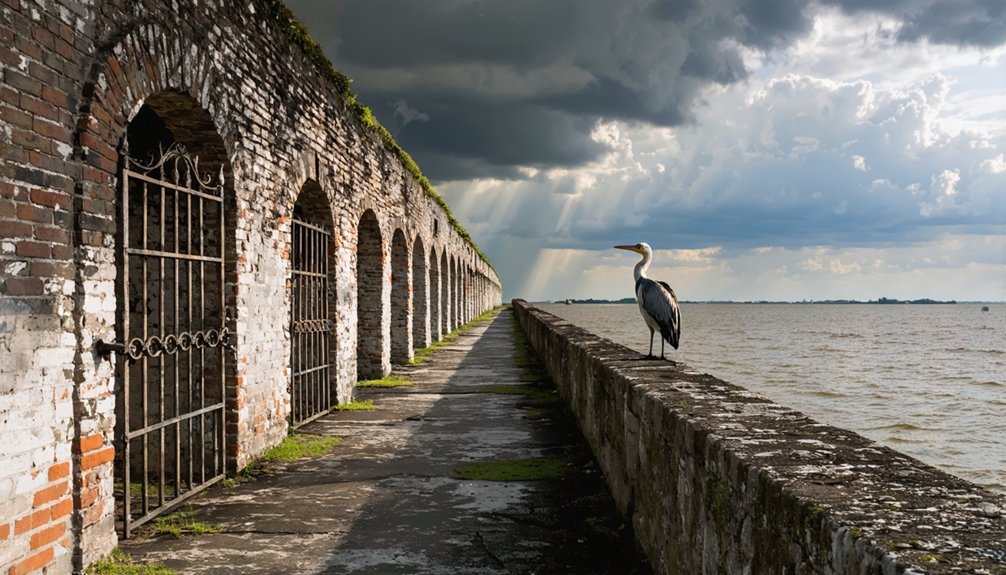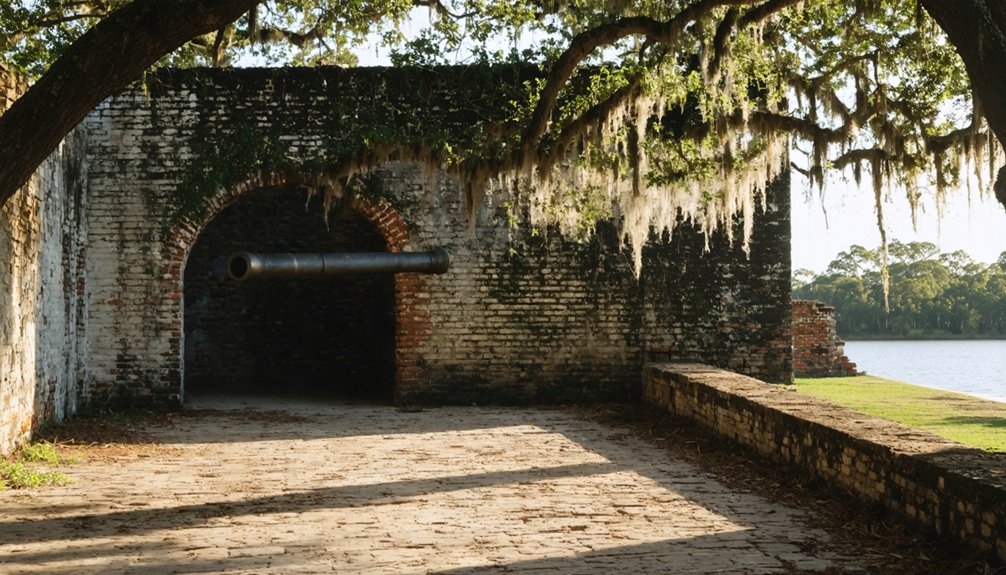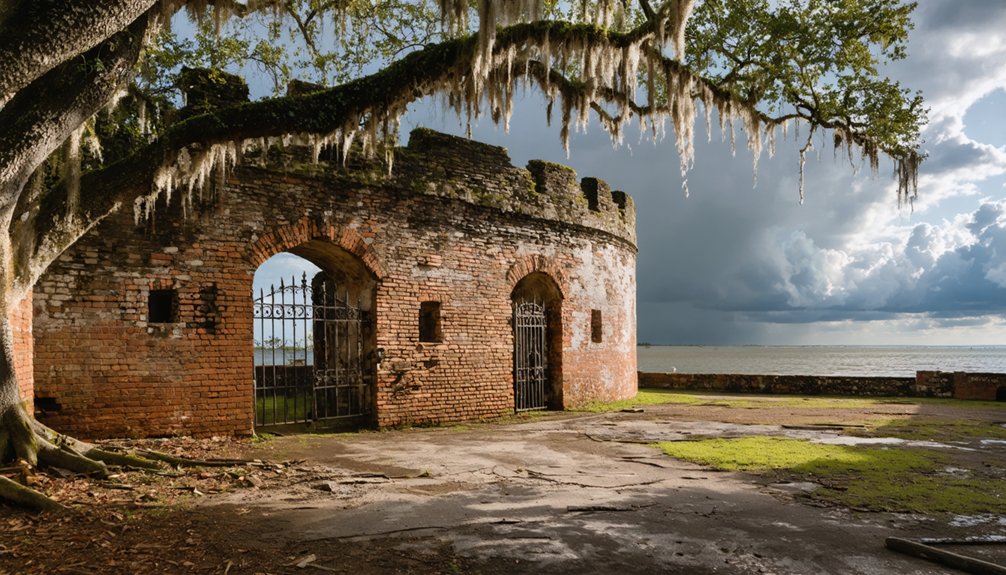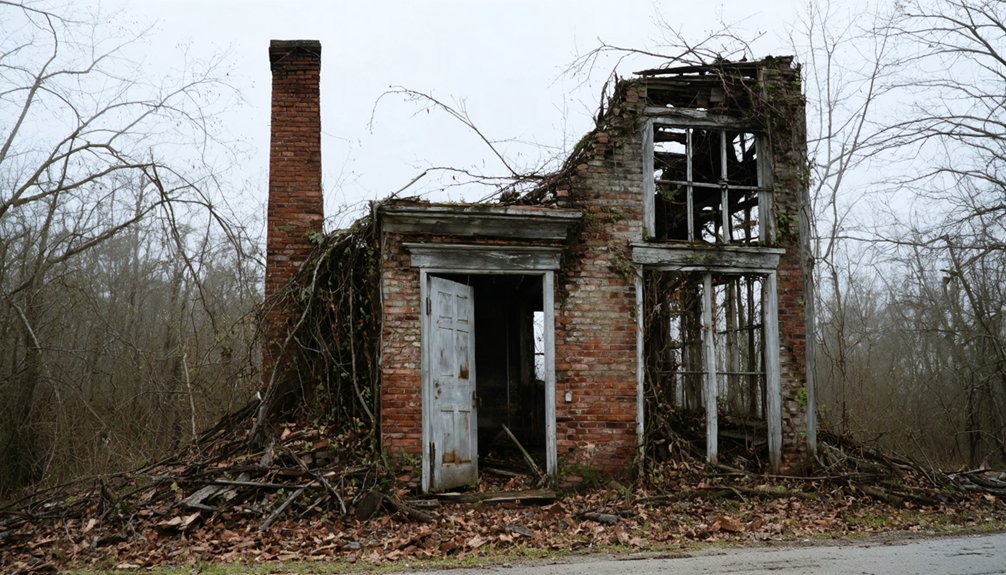You’ll find Fort Gaines standing guard at Dauphin Island’s eastern tip, a remarkably preserved Civil War fortress that’s battling time and tide. Built in 1821 as part of America’s coastal defense, this pentagonal stronghold witnessed the pivotal Battle of Mobile Bay in 1864 before serving through both World Wars. Today, you can explore its mysterious tunnel systems, watch blacksmithing demonstrations, and wander through original officer quarters – but hurry, as the Gulf’s waters steadily threaten this historic treasure.
Key Takeaways
- Fort Gaines is not a ghost town but an active historic fort site open daily for visitors on Dauphin Island.
- The surrounding area experienced population decline after military operations ceased following World War II.
- The fort complex includes five preserved pre-Civil War brick buildings that remain accessible to tourists.
- Severe erosion threatens the fort’s existence, with shorelines receding up to 10 feet annually.
- Original structures including tunnels, kitchens, and officer quarters remain intact, maintaining the fort’s historical authenticity.
The Birth of a Strategic Fortress
While French, British, and Spanish colonizers had previously occupied Dauphin Island, Fort Gaines‘ establishment in 1821 marked a new era in America’s coastal defense strategy.
As part of the Third System of coastal fortifications, military planning focused on securing the strategic location at Mobile Bay‘s entrance, where you’ll find Fort Gaines standing guard at the eastern tip of the island.
Construction wasn’t without its challenges – frequent flooding halted initial progress in the 1820s.
When work resumed in 1857, Army Chief Engineer Joseph Totten implemented an advanced design featuring a dry moat and innovative defensive structures.
The fort’s revised 1853 design incorporated features to endure a six-month siege with enhanced military architecture.
The Confederacy ultimately completed the fort in 1862, creating one of the nation’s most formidable coastal defenses, designed to protect American interests from threats approaching through the Gulf of Mexico.
Today, visitors can explore the fort’s original cannons and historic structures that have been remarkably preserved.
Wartime Tales and Military Legacy
As Union forces closed in on Mobile Bay in August 1864, Fort Gaines stood as a formidable Confederate stronghold guarding the eastern channel.
Despite being designed to withstand a six-month siege, the fort’s 818 defenders surrendered to Union Major General Gordon Granger after just five days of bombardment. The fort’s relatively small arsenal of only 26 guns proved insufficient against the Union fleet’s massive firepower. The fort was built in 1818 as part of a coastal defense system to protect Mobile Bay.
You’ll find that the fort’s wartime legacy extends far beyond the Civil War.
While modern-day military ghostbusters haven’t confirmed any paranormal activity, the fort’s tunnels and chambers echo with ghost stories from its service in the Spanish-American War and both World Wars.
The Coast Guard used it to watch for enemy submarines during WWII, and today you can explore the original blacksmith shop, bakery, and museum.
Though endangered by shoreline erosion, Fort Gaines continues to preserve its rich military heritage through living history demonstrations.
Architectural Marvels and Design Features
As you explore Fort Gaines, you’ll notice its distinctive pentagonal shape, a strategic military design that mirrors its sister fortification, Fort Morgan, across Mobile Bay.
The fort’s original 19th-century brick and stone masonry stands as a tribute to period construction techniques, featuring lower curtain walls and smaller bastions than contemporary coastal defenses. These architectural elements were part of General Totten’s plans for modernizing the fort’s defenses.
Walking through the carefully preserved grounds, you can examine the intricate brickwork of the entrance sally port and the connecting tunnel system that links the fort’s defensive bastions. The fort’s three-story officers’ quarters were largely damaged during battle, with only the lower level remaining intact.
Pentagonal Defense Layout
A masterpiece of military engineering, Fort Gaines showcases the strategic brilliance of its pentagonal design, with five symmetrical sides arranged to maximize defensive capabilities at Mobile Bay’s western entrance.
The fort’s pentagonal symmetry follows French military principles, ensuring extensive protection against both land and sea attacks. Brick arched tunnels and passageways enhance the fort’s defensive capabilities while providing protected movement for troops. Construction used slave labor bricks from Dog River to create the formidable fortress walls.
The bastion advantages of Fort Gaines’ design include:
- Overlapping fields of fire from all five corners
- Up to 50 artillery pieces mounted across the walls
- Four flank howitzers in each bastion for enhanced coverage
- Enfilading fire capabilities along attacking force lines
- Minimal dead zones for potential enemy approaches
You’ll find this defensive marvel positioned perfectly at Dauphin Island’s eastern tip, controlling crucial shipping channels while embodying the Third System of U.S. coastal fortifications.
Original Masonry Construction
Mighty walls of red brick stand as evidence to Fort Gaines‘ original Third System masonry construction, showcasing the engineering prowess of early 19th century U.S. Army engineers.
You’ll find impressive masonry techniques throughout, from the thick-walled vaulted casemates to the two-story officers’ quarters within the parade ground.
The fort’s historical resilience is remarkable – despite challenges from high tides during foundation work and ongoing shoreline erosion, the original lime mortar and brickwork have endured nearly two centuries.
Inside, you can explore a network of tunnels connecting the bastions, and five pre-Civil War structures including a blacksmith shop and kitchens. The arched passageways provided essential ammunition magazine access during wartime operations.
While later modifications added concrete elements, the core masonry remains largely intact, earning Fort Gaines recognition on the National Register of Historic Places. The fort’s eastern position has made it especially vulnerable to tropical storm damage, requiring continuous repairs to preserve its historic walls.
Life Behind the Brick Walls
While Fort Gaines’ imposing brick walls protected its military operations from outside threats, life within the fortification bustled with the daily activities of hundreds of Confederate soldiers during the Civil War.
Behind Fort Gaines’ mighty walls, Confederate soldiers maintained a bustling military community, carrying out their daily duties during the Civil War.
Their daily routines revolved around maintaining the fort’s readiness and sustaining its garrison, from weapon upkeep to basic survival needs like using the communal latrines that served over 400 men.
Behind these historic walls, you’ll discover the authentic remnants of 19th-century military life:
- A functioning blacksmith shop where weapons and tools were repaired
- Original kitchen facilities where meals were prepared for the entire garrison
- An intricate network of tunnels used for secure movement throughout the fort
- Preserved officer quarters reflecting military life of the era
- Battle-ready artillery positions connected by spiral stone staircases
Defending Mobile Bay Through History

Strategically positioned at the eastern tip of Dauphin Island, Fort Gaines played a pivotal role in defending Mobile Bay‘s entrance for over 150 years.
You’ll find evidence of evolving naval strategies throughout the fort’s history, from its original Civil War-era cannons to the Spanish-American War’s “disappearing guns.”
During the Battle of Mobile Bay in 1864, the fort’s 26 guns and 818 men faced overwhelming Union forces before surrendering to Admiral Farragut’s fleet.
The fort’s coastal defenses included innovative features like corner bastions, spiral stone staircases, and tunnel systems.
Even after the Civil War, Fort Gaines continued protecting Gulf Coast shipping lanes through both World Wars, cementing its legacy as a cornerstone of American military defense.
Preservation Challenges and Modern Threats
Despite its enduring military legacy, Fort Gaines now faces an array of critical preservation challenges that threaten its survival.
Gulf waves and storms drive severe erosion impact, with shorelines receding up to 10 feet annually.
You’ll find the fort’s historic 19th-century masonry increasingly vulnerable to weather damage, while salt spray and humidity steadily wear away at its structure.
Living History and Cultural Heritage

Through its vibrant living history programs and cultural preservation efforts, Fort Gaines brings the American Civil War era to life for modern visitors.
Step back in time as Fort Gaines’ dynamic living history exhibits transport you to the heart of Civil War America.
You’ll witness costumed interpreters demonstrating period-accurate blacksmithing and firing original cannons that once defended Mobile Bay. The fort’s five pre-Civil War brick buildings and tunnel systems provide an authentic backdrop for these cultural experiences.
You can explore exhibits featuring artifacts like the USS Hartford’s massive anchor while learning about Admiral Farragut’s famous “Damn the torpedoes” command.
The site’s rich heritage spans French, British, Spanish, and Native American influences, making it more than just a Civil War fortification.
Whether you’re watching historical reenactments or taking guided tours led by uniformed interpreters, you’ll find yourself immersed in the compelling story of this strategic stronghold.
Exploring Fort Gaines Today
When you visit Fort Gaines today, you’ll find one of America’s best-preserved Civil War-era masonry forts perched on Dauphin Island’s eastern tip at 30°14′54″N 88°04′32″W.
The current exhibits and visitor experiences immerse you in rich military history while showcasing the fort’s architectural marvels.
- Explore the museum featuring Admiral Farragut’s USS Hartford anchor and original Civil War cannons
- Watch live blacksmithing demonstrations in the operational workshop
- Navigate through mysterious tunnel systems with spiral stone staircases
- Tour five pre-Civil War brick buildings and historic kitchens
- Witness thrilling cannon firing demonstrations by knowledgeable guides
Though facing serious erosion threats, Fort Gaines remains open daily with wheelchair accessibility and pet-friendly policies, making it an essential stop for history enthusiasts seeking authentic Civil War heritage.
Frequently Asked Questions
Are There Documented Ghost Sightings or Paranormal Activities at Fort Gaines?
You’ll find numerous ghost stories about gunshots, cannon fire, and a woman in military attire, though paranormal investigations haven’t scientifically verified these claims beyond visitor and staff testimonials.
What Happened to the Original Native American Inhabitants of Dauphin Island?
You’ll find Dauphin Island’s original inhabitants faced nature’s quieting touch through disease, while others joined mainland tribes. Their cultural impact lives on through shell middens and artifacts they’ve left behind.
How Much Does It Cost to Visit Fort Gaines?
You’ll pay $8-10 for adult admission fees and $4-5 for children’s ticket prices. There’s also a parking fee of $10.37 for three hours, with special event rates costing more.
Is Fort Gaines Accessible for Visitors With Mobility Limitations?
Yes, you’ll find wheelchair accessibility throughout main areas, with paved parking and accessible facilities. However, some historic ramparts and tunnels have limited mobility options due to architectural preservation requirements.
Can Fort Gaines Be Rented for Private Events or Weddings?
You won’t find event rentals or wedding packages at this historic site. It’s not available for private functions, though you can explore alternative venues nearby on Dauphin Island for your special occasion.
References
- https://www.historyhit.com/locations/fort-gaines/
- https://www.legendsofamerica.com/al-fortgaines/
- https://www.townofdauphinisland.org/things-to-do/historic-fort-gaines
- https://fort-gaines.com
- https://en.wikipedia.org/wiki/Fort_Gaines_(Alabama)
- https://gulfcoastjourneys.com/historic-fort-gaines/
- https://www.battlefields.org/visit/heritage-sites/fort-gaines-historic-site
- https://www.malagainn.com/Blog/DiscoverHistoricFortGainesGuardianofMobileBay.html
- https://alabama.travel/places-to-go/historic-fort-gaines
- https://armyhistory.org/a-tale-of-two-forts/



